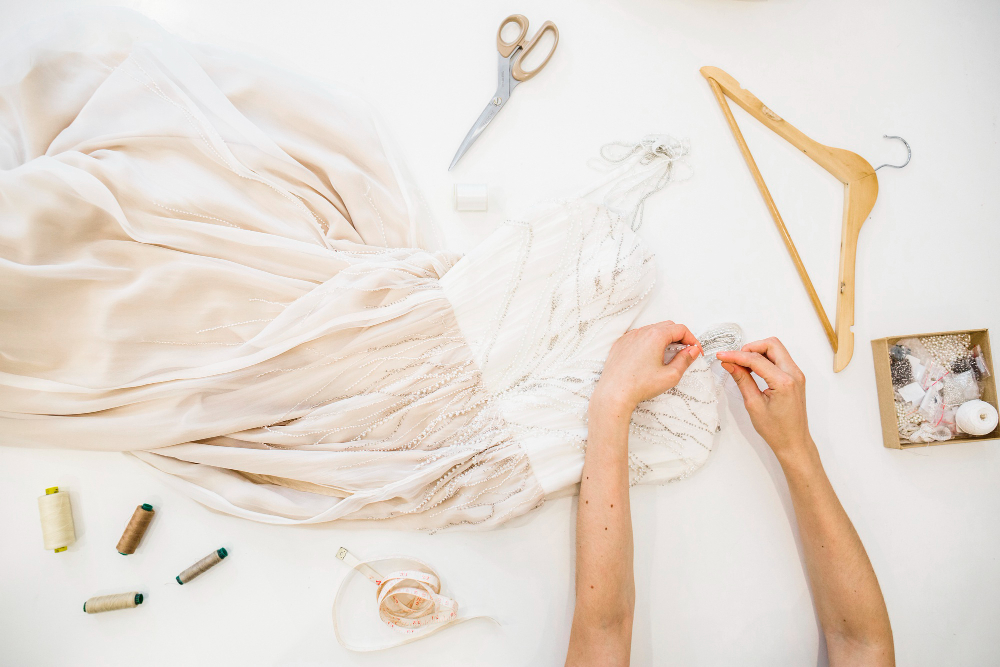It’s no big deal when we want our pants hemmed or a casual top taken in a little. Quick fixes like that are part of everyday life. But can the same simple alterations be applied to couture pieces, those made with rare fabrics, hand-stitched details, and hours (sometimes hundreds of hours) of craftsmanship behind them?
Not exactly, although that doesn’t mean couture can’t be altered at all. It just means it has to be performed with a whole different level of skill, planning, and respect for the original craftsmanship. In this post, we break down what you can safely alter and where you need to be extra cautious.
Couture Pieces That Are Safe to Adjust
When it comes to altering couture clothing, the safest way to go is by starting with pieces that have structure and design elements that can handle small changes without falling apart. These are usually garments that don’t rely heavily on embroidery, hand-sewn detailing, or delicate textiles like lace. The idea here is that you can make small tweaks to improve the fit or functionality without risking the integrity or original look of the item.
Let’s walk through some common couture pieces you can adjust, the kind of changes that make sense, and how to do it right.
1. Trousers (Pants)
Couture trousers are often made with tailoring in mind, meaning they usually include extra seam allowance (extra fabric sewn into the seams) to allow for future adjustments. Whether it’s taking in the waist, hemming the legs, or adjusting the hips, these changes are generally straightforward for a skilled tailor.
Alteration Tips:
- Ask your tailor to keep the original hem if possible, especially if there’s a special design at the cuff.
- Don’t try to change the rise or crotch area unless your tailor specializes in trouser construction.
- Always check the inner lining if it’s a fully lined piece – altering both the outer and inner layers requires advanced skill.
2. Skirts
Skirts, especially those without embroidery or heavy beading, are generally simple to alter. A-line and pencil skirts are most common in couture, and both types allow for safe changes like adjusting the waistband or hemline. The construction is clean and doesn’t usually interfere with critical structural elements.
Alteration Tips:
- If the skirt has a zipper or button closure, ask your tailor to move the closure instead of altering the entire waist.
- Shortening a skirt is usually safe, just make sure any design elements (like pleats or lace) don’t get chopped off in the process.
- When adjusting the waist, have the tailor check how the new fit will impact the way the skirt falls over your hips.
3. Suit Jackets and Blazers
High-end jackets are made to be tailored. Couture suit jackets often come with extra fabric sewn into the seams, making them a dream for alterations. Adjusting the sleeve length, slimming the sides, or even taking in the shoulders (with advanced skill) are all doable.
Alteration Tips:
- Don’t mess with the shoulder pads unless you’re working with a true expert – it’s one of the trickiest areas to adjust.
- Ask to preserve the original buttons, especially if they’re custom or hand-stitched.
- Sleeve shortening should always be done from the cuff, not the shoulder, unless the sleeve has special embroidery or vent details.
4. Shirts and Blouses
If you have a couture shirt or blouse made from cotton, silk, or satin, there’s usually some room for gentle alterations. Common fixes include slimming the sides, shortening the sleeves, or adjusting the collar.
Alteration Tips:
- Be careful with pieces that include delicate lace or button plackets.
- Avoid resizing if the shirt has a lot of darts (small sewn folds) that control shape – they’re hard to reposition.
- As always, go to a professional tailor near you who understands how to work with high-end fabrics.
5. Simple Gowns (Without Heavy Beading)
Couture gowns with clean lines and minimal embellishments (think classic silhouettes in satin, crepe, or chiffon) can usually be hemmed, have their straps adjusted, or be taken in at the sides. As long as there’s no heavy embroidery or complicated internal structure, it’s safe to make basic changes.
Alteration Tips:
- Ask if the hem can be adjusted from the waist (instead of cutting from the bottom) to preserve any design at the hemline.
- If the gown has multiple layers, make sure all layers are shortened evenly.
- Avoid adjusting anything close to the bust unless you’ve had a fitting and the tailor has experience with gown construction.
Couture Pieces That Are Risky to Alter

Now let’s talk about the tricky stuff. Some couture items just weren’t made with alterations in mind. Whether it’s because of delicate fabrics, built-in structure, or complex design elements, these pieces are better left as they are or handled very carefully by a specialist with experience in couture tailoring. Trying to make even a small change to these garments can lead to rips, distortion, or a complete loss of the original shape and flow.
Here are some couture pieces you should think twice about before altering, plus some alteration tips:
1. Embroidered or Beaded Bodices
These are some of the most delicate areas on any couture piece. Whether it’s a wedding dress, evening gown, or formal blouse, bodices with intricate embroidery or hand-beading can’t be taken apart without damaging the detailed work. Even a small needle puncture can ruin hours of craftsmanship.
Alteration Tips:
- If you absolutely need to alter it, ask if the tailor can remove and reapply the beading – this takes time and skill and isn’t always guaranteed to work.
- Avoid side seam adjustments unless they’re far away from the detailed areas.
- For fit issues, consider external solutions like fashion tape, corset ties, or supportive undergarments instead.
2. Lace Wedding Dresses with Boning
These dresses are often made with internal boning (plastic or metal strips sewn into the lining to give shape), which makes them hard to take in or let out. Combine that with delicate lace overlays, and you have a dress that’s very easy to damage.
Alteration Tips:
- If you must make changes, find a wedding dress specialist, not just a general tailor nearby.
- Boning may need to be completely removed and resewn – a complex and expensive process.
- Avoid altering the bust or waist unless absolutely necessary.
3. Leather Couture Pieces
Leather doesn’t “give” the way woven fabrics do. Once it’s sewn or punctured, the holes are permanent. That means adjusting seams, zippers, or even shortening sleeves can be risky.
Alteration Tips:
- Only use a tailor who specializes in leather and has examples of previous work.
- Don’t attempt DIY sewing because leather needs special machines and needles.
- Keep in mind that dye-matching or patching is extremely difficult if anything goes wrong.
4. Draped or Bias-cut Gowns
Bias-cut gowns (those cut diagonally across the fabric grain) flow and stretch in unique ways. Altering them can throw off the drape and cause the garment to hang unevenly or cling in the wrong places.
Alteration Tips:
- It’s safer to add a hidden belt or internal ties than to cut into the seams.
- Avoid shortening these gowns – they were designed to fall a certain way, and adjusting the length can ruin the silhouette.
- If you must tailor it, insist on multiple fittings and test how the fabric reacts after changes.
5. Fully Lined Couture Coats or Jackets
When a coat is fully lined, you can’t simply open it up and make changes. You have to deal with both the outer layer and the lining, sometimes even hidden interfacing or insulation. This makes sleeve or shoulder adjustments extremely hard to get right.
Alteration Tips:
- Ask your tailor if they can “mirror” the adjustment on both layers. This requires extra time and effort.
- Be wary of altering shoulder pads or sleeve width – both affect the entire fit and drape.
- Consider tailoring the fit by altering the arm or back seams, rather than more noticeable areas.
Need Expert Couture Alterations? Only Trust the Seasoned Tailors at Pristine Fine Dry Cleaning!
Couture clothing is designed with rare fabrics, intricate stitching, and a structure that’s built to last. But when it needs adjustment, it demands more than your average tailor – it calls for a steady hand, a trained eye, and years of experience working with delicate, high-value garments.
At Pristine Fine Dry Cleaning, we specialize in fine alterations for both men’s and women’s couture clothing, offering precision tailoring that respects the craftsmanship behind each piece. Need more than a fit fix? We also offer professional clothing repair, restoring worn or damaged areas without compromising the look, feel, or integrity of your garment.
We have two convenient locations in Naples: 506 9th Street N and 4596 Tamiami Trail N. Contact us today at 239-788-0360 to schedule an appointment or to discuss your custom tailoring needs!


